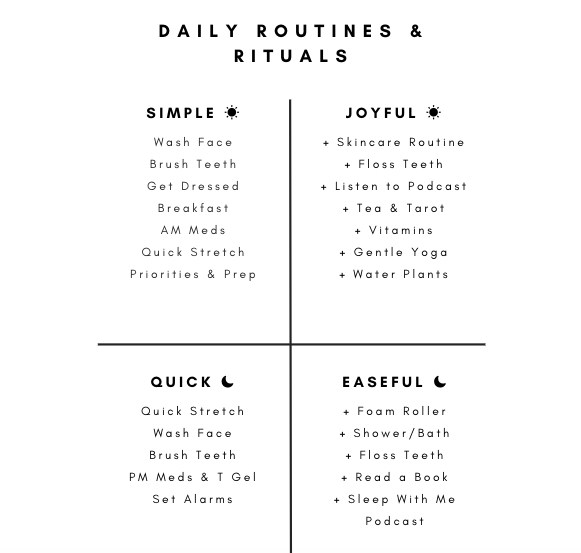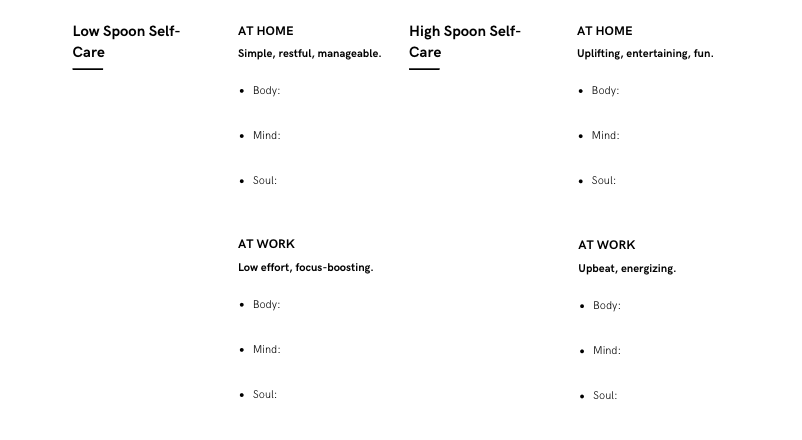Let's talk about ADHD, and the mistakes you might be making when building a day-to-day routine for yourself. 

Ready, set... thread!


Ready, set... thread!
(1) BEING TOO AMBITIOUS.
We all have an ideal routine in our minds that we'd like to follow, because we know it would make us feel good, and give us the start to our day that we've always dreamed of.
And? This sets us up to get discouraged v quickly.
We all have an ideal routine in our minds that we'd like to follow, because we know it would make us feel good, and give us the start to our day that we've always dreamed of.
And? This sets us up to get discouraged v quickly.
There's a workaround that I do with my ADHD coaching clients: I have them make two routines. You can do this, too!
On the left column, give yourself the bare minimum, simplest routine you can come up with. On the right, put your extra credit/bonus tasks that you'd like to do.
On the left column, give yourself the bare minimum, simplest routine you can come up with. On the right, put your extra credit/bonus tasks that you'd like to do.
This tricks your brain a little! With ADHD, it can be hugely challenging to start your day. But if you give yourself the low-spoon routine first, and let that be enough, you often end up with enough momentum to tackle some bonus tasks, too.
This is an example of a routine that I might put together, divided by simple routine versus bonus tasks.
(I create worksheets like these for my clients, and FYI, I'm uploading this one to Patreon today, hint hint.)
(I create worksheets like these for my clients, and FYI, I'm uploading this one to Patreon today, hint hint.)
Will I do every task in this chart? Nope!
But if I do something like cleansing my face, I might find that I have extra energy to follow through on my skincare routine. So I try, for each basic task, to offer an "advanced" option in case I have a moment where I'm feeling it~
But if I do something like cleansing my face, I might find that I have extra energy to follow through on my skincare routine. So I try, for each basic task, to offer an "advanced" option in case I have a moment where I'm feeling it~
A chart like this also teaches us to tune into our own natural rhythms around energy and motivation.
We may find that we stick to a simple routine in the morning, while we have more energy in the evening. Or, we may learn that we need to lower the bar more on both.
We may find that we stick to a simple routine in the morning, while we have more energy in the evening. Or, we may learn that we need to lower the bar more on both.
Remember, when you're experimenting with a routine, you're actually gathering information. There's no way to "fail."
Instead, you're learning about how your brain works, where your energy is high and where it's lower, and what is and isn't serving you!
Instead, you're learning about how your brain works, where your energy is high and where it's lower, and what is and isn't serving you!
(2) TRYING TO CHANGE YOUR OWN RHYTHM.
You may not be the kind of person that gets up early to meditate. And you may never be the kind of person that does that.
And that's okay. You don't actually have to be. Your nighttime routine is just as valuable as your morning routine.
You may not be the kind of person that gets up early to meditate. And you may never be the kind of person that does that.
And that's okay. You don't actually have to be. Your nighttime routine is just as valuable as your morning routine.
A lot of people have this misconception that you have to be a morning person to create more time and space in your day. But actually, there are plenty of moments throughout the day and in your evening that you can take advantage of.
If you DO still want to aim for being a morning person, use the night before to make your morning easier and more exciting (lay out your breakfast, choose your outfit, put your Nintendo Switch in the living room — anything that makes it easier to get up!).
To make the most of those in-between moments in your day, you can also aim to plan your self-care options ahead of time, using the same method of choosing two — low-energy and high-energy activities.
Like so!
Like so!
You don't need to wake up at five AM to find time for yourself. Simply having an idea of how/when you want to use that time, and how you'll make those transitions easier for yourself, can be enough to get you going.
(3) GETTING DISCOURAGED WHEN IT "DOESN'T WORK."
You're going to have twelve thousand iterations of your routine. Sometimes because you're still getting to know your own energy levels! Sometimes because your schedule changes! And a lot of the time? Because you get bored.
You're going to have twelve thousand iterations of your routine. Sometimes because you're still getting to know your own energy levels! Sometimes because your schedule changes! And a lot of the time? Because you get bored.
The reframe that's really important is this: We're getting CURIOUS about ourselves. We're not trying to shame ourselves into shifting our routine... we're experimenting and getting to know ourselves and our brains better. 



This is why I believe in creating two iterations of a routine and to keep modifying it as you go.
Eventually, you'll have a clear map that shows you where your energy is high and where it's low, where and when to set the bar low, and what "extra credit" is feasible for you.
Eventually, you'll have a clear map that shows you where your energy is high and where it's low, where and when to set the bar low, and what "extra credit" is feasible for you.
It's okay to aspire to a more luxurious routine! But that's not where you should set the bar to start with. You set the bar as low as you can, while keeping in mind some of your aspirations. Aspirations are OPTIONS, though. They aren't the starting place.
Often with ADHD, the "getting started" part is so intimidating and frustrating, we freeze up. The goal is to create the simplest routine possible, knowing that if we feel capable of doing more, we have the option to. Emphasis on option. ...perfectionists, do you hear me? OPTION.
So for example, a simple bedtime routine for me is spraying some essential oils on my pillow (with a bottle I keep on my bedside table). I brush my teeth, take my meds, and pass out listening to the same podcast (Sleep With Me) that I always do.
Basic. Self-compassionate. And feasible on a day when I don't feel motivated to do much of anything.
My bonus routine adds onto each task. So with those essential oils, I might draw a tarot card to reflect on. When I brush my teeth, I might also use some skincare products while I'm in the bathroom. I might choose a different podcast to shake things up.
The two-routine format works not only because it makes the "cost of entry" a lot more attainable, but because creating new habits is more successful if we tack them onto existing habits. Which is why it's better to think of that second routine as "extra credit."
Anyway, I like to teach clients this two-column trick because I find that setting the bar too high, working against their own natural rhythms, and getting discouraged early on are three major obstacles in creating routines that work for them!
I'll be uploading some of the worksheets I used here onto my Patreon later today, and if you ever want a cheerleader to help you work through them, I offer coaching, too. 
http://patreon.com/samdylanfinch http://samdylanfinch.com/coaching

http://patreon.com/samdylanfinch http://samdylanfinch.com/coaching
Bottomline, though? Be kind to yourself, be flexible, and be curious.
You've got this!
You've got this!

 Read on Twitter
Read on Twitter



